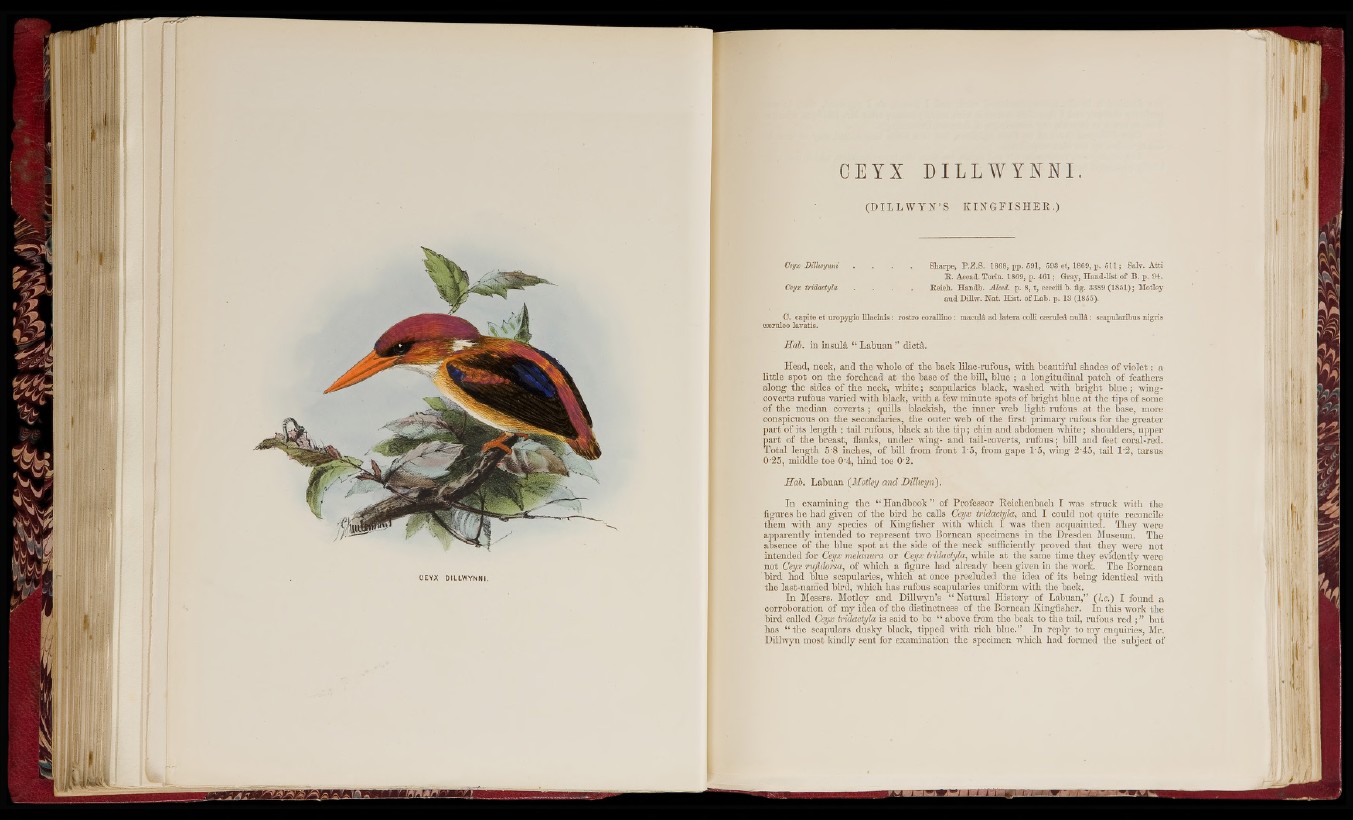
- CEYX DILLWYNNI.
3 ?
i I
C E Y X D I L L W Y N X I
( D I L L W Y N ’S K I N G F I S H E R . )
li 1,
Ceyx mUwynni . . . . Sharpe, P.Z.S. 18C8, pp. 591, 593 et, 1869, p. 511 ; Solv. Atti
E. Accad. Torin. 1869, p. 461 ; Grray, Hand-list of B. p. 94.
Ceyx tridactyla . . . . Eeich. Handb. Alced. p. 8, t, cecciii b. fig. 3389 (1851) ; Motley
audDillw. Nat. Hist, of Lab. p. 13 (1855).
0 . capite et uropygio lilacinis : rostro corallino : maeulâ ad latera coUi cæniled nvdlâ : scapulaiibus nigris
cæruleo lavatis.
Kah. in insula “ Labuan ” dictâ.
Head, neck, and the whole o f th e back lilac-nafous, with b eautiful shades o f violet ; a
little spot on th e forehead a t the base o f the bill, blue ; a longitudinal p atch o f feathers
a long th e sides o f th e neck, white ; scapulai’ies black, washed with b rig h t blue ; wing-
coverts rufous v a ried w ith black, with a few m in u te spots o f b r ig h t blue a t tbe tips o f some
o f th e median coverts ; quills blackish, th e in n er web lig h t rufous a t the base, more
conspicuous on th e secondaries, the o u ter web o f the firs t pi’imary rufous for the g reater
p a rt o f its len g th ; tail rufous, black a t th e tip ; chin and abdomen white ; shoulders, upper
p a rt o f th e b reast, flanks, u n d e r wing- an d tail-coverts, rufous ; b ill aud feet coral-red.
Total len g th 5'8 iuches, o f b ill from fro n t 1'5, from gape 1'5, wing 2'45, ta il 1’2, tarsu s
0-25, middle toe 0'4, hin d toe 0'2.
Bab. Lab u an {Motley and Dillwyn).
In ex amin in g th e “ Handbook ” o f Professor Reichenbach I was stru ck with the
figures he had given o f th e b ird h e calls Ceyx tridactyla, and I could n o t quite reconcile
them with any species o f Kingfisher with which I was then acquainted. They were
apparently intended to rep resen t two Bornean specimens in th e Dresden j\Iuseum. The
absence o f tb e blue spot a t the side o f the neck sufficiently proved th a t th ey were not
intended for Ceyx melanura o r Ceyx tridactyla, while at the same time they evidently were
not Ceyx I'ufidorsa, o f wliich a figure had already been given in the work. The Bornean
b ird h ad blue scapularies, which a t once precluded th e idea o f its b e i r ..........................
the last-named bfrd, which has rufous scapularies uniform with the back.
In Messrs. Motley and Dillwyn’s “ N a tu ra l Histo ry o f Labuan,” { lc .) I found a
corroboration o f my idea o f th e distinctness o f the Bornean Kingfisher. In this work the
bfrd called Ceyx tridactyla is said to be “ above from the beak to th e tail, rufous red b u t
bas “ th e scapulars d usky black, tipped with rich blue." In reply to my enquiries, Mr.
DiUwjui most kindly sent for examination th e specimen which had formed the subject of
‘■i: ‘
' '
2ii À t.